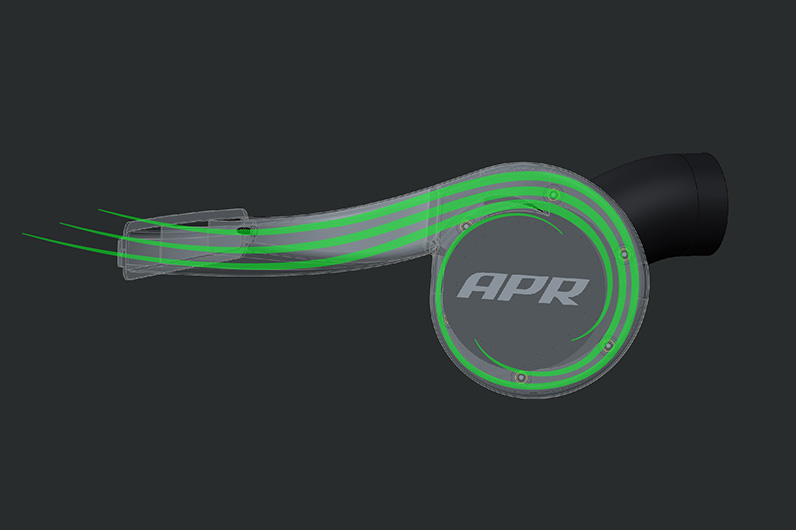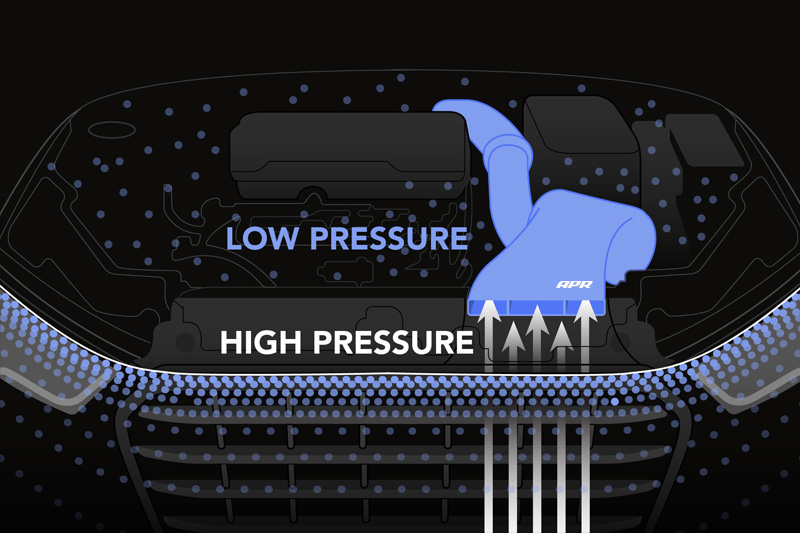 WARNING: This product can expose you to chemicals that are known to the State of California to cause cancer, birth defects or other reproductive harm. For more information, visit www.P65warnings.ca.gov.
WARNING: This product can expose you to chemicals that are known to the State of California to cause cancer, birth defects or other reproductive harm. For more information, visit www.P65warnings.ca.gov.The APR Carbon Fiber Intake System is an attractive high performance upgrade for the latest 1.8T and 2.0T engines as found in various MQB platform vehicles.
The factory intake design has the foundation for excellent performance, but much of this is sacrificed in an effort to meet other design requirements. With requirements set forth for only supporting factory power output levels, low engine sound levels and long service intervals, there is plenty of room for improvement.
The APR Carbon Fiber Intake System increases performance primarily by improving mass airflow through the system while still proving adequate filtration. Expect greater horsepower and torque through the power band with a more direct and responsive feel upon pressing the throttle. Sounds from the engine and turbocharger are enhanced and some may even experience better fuel economy depending on driving style.
Airflow
Intake housing Flow Bench Analysis

Intake Filter Flow Bench Analysis

Improving Pressure Ratio
In an effort to strive for an ideal pressure ratio (1:1) between the intakes inlet and outlet, the intake features several key characteristics:
Volute Filter Chamber

Through CFD optimization and flow-bench validation, the intakes filter housing was shaped into a reducing spiral, or volute, which uses the inertia of the air entering the system to increase pressure on the outside of the filter. This creates an even pressure distribution across the entire face of the filter, rather than only a few key spots, and as such, maximizes utilization of the filtration element.
Compared to many other popular intake styles, the APR intake system allows for the use of a small, compact filter with better filter utilization as systems often twice its size.
High Pressure Inlet Snorkel and Sealed Design

Unlike traditional open element filters, the APR intake design only pulls air from the grille area near the leading edge of the vehicles hood. In doing so, it draws air from an area of relatively high pressure. As the vehicle increases in speed, pressure continues to build and ultimately aids in the intakes effectiveness.
By sealing the intake system, pressure created during the ram air effect and volute design is not simply lost within the engine bay. This is contrary to open element filters that pull air from a relatively low pressure region formed within the engine bay.
Intake Air Temperature Management
Intake air temperature (IAT) plays a critical role in engine performance, especially on turbocharged engines where the ambient air temperature is raised twice through both compression via the turbocharger, and then again during the engines compression stroke.
In an effort to maintain the lowest possible starting IAT, the APR Intake system begins by drawing air from the coldest possible location, which is the front end of the vehicle before the radiator. Air travels a short path through the intake system, past the filter and on its way to the turbocharger through a sealed intake design that prevents ingestion of hot, under-hood air. Finally, the intakes carbon composite design features a thin fiberglass backing, which improves thermal insulative properties.
Optional Accessories
Turbo Inlet Pipe
The APR Carbon Fiber Turbo Inlet Pipe replaces the rear factory plastic accordion tube with an attractive carbon fiber inlet, complementing the APR Intake Systems aesthetically pleasing design. The intake and inlet hose are joined via a necessary flex coupler to allow for adequate engine movement under use without damaging the intake. The turbo inlet pipe is completely compatible with all factory turbochargers and APRs Stage III Turbocharger System.
Coolant Hose
The factory coolant hose is designed to be routed over the top of the intake system. However, when routed underneath the intake, its far more aesthetically appealing. The APR coolant hose replaces the factory unit and routes cleanly under the intake and around the APR catch can without kinking or adding extra stress to the mounting points.
Secondary Air Injection (SAI) Filter
For Vehicles equipped with secondary air injection (SAI), an SAI filter is required.
TT Adapter Kit
The Audi TT and TTS requires adapter #CI100033C
Sound Test
Notes:
Vehicles equipped with secondary air injection (SAI) require the SAI filter below.
This intake does not fit vehicles with the Gen 3B engine.
- PDP tag:
- Free Shipping*
- Sale:
- On Sale
- pdp tag:
- On Sale








